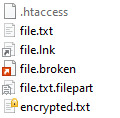This is an old revision of the document!
File Panels
File panel is the most important part of the interface. Using it the user can select the files to work with. There is panel listing files in current remote directory in both interfaces. The Norton Commander interface has also panel listing files in current local directory.
Advertisement
- Selecting Files
- Selecting Columns
- Directory Tree
- Sorting Files
- Path Label
- Panel Toolbars
- View Style
- Special Files
Selecting Files
Method for selecting files differs with interface your are using.
- Selecting files in Norton Commander interface
- Selecting files in Explorer-like interface is the same as you know from Windows Explorer.
Commands for selecting files are available from Mark menu.
Selecting Columns
In the Norton Commander interface and in details view of the Explorer-like interface, the file panels shows several column containing information about the files. User can select which columns should be displayed and their order.
Advertisement
| Column | Panel | Description |
|---|---|---|
| Name | Both | File name. |
| Size | Both | File size. |
| Type | Both | Description of the file type (if known). |
| Changed | Both | Time of the last modification of the file. |
| Attr | Local | File attributes. a stands for archive, r for read-only, h for hidden, c for compressed, s for system. |
| Rights | Remote | File permissions. Three groups of three letters. The first group for owner, the second for group and the last for others (so called world). r stands for read, w for write and x for execute (for directories it means permissions to open/enter the directory). The columns is empty, if the server does not support UNIX-style permissions. |
| Owner | Remote | File owner. |
| Group | Remote | File group. |
| Link target | Remote | Target of symbolic link. |
To show/hide columns use context menu of the column titles. Alternativelly use the main menu (View > Show Columns in Explorer-like interface, Local (Remote) > Show Columns in Norton Commander interface).
To change column order, drag the column title. To change column width, drag the separator between the column titles.
Directory Tree
Optional component of the file panel is directory tree. You can use it to change current directory. You can also copy/move directories it shows using drag&drop or drop files and directories on it.
On startup, remote directory tree shows only all parent directories of the initial remote directory. As you visit other directories, content of the tree is being filled.
To show/hide the tree use keyboard shortcut Ctrl+Alt+T, toolbar button or the main menu
(View > Tree in Explorer-like interface,
Options / Local (Remote) Panel > Tree in Norton Commander interface).
Sorting Files
Files in panel can be sorted by value of any column. To sort the list click on column title by which you can sort the files. To reverse the ordering, click on the same column title again. Note that there are no titles in the Explorer-like interface in icon view.
Alternativelly the sorting can be set from the main menu (View > Sort in Explorer-like interface, Local (Remote) > Sort in Norton Commander interface).
Path Label
In Norton Commander interface there is path label over each panel. It shows path to current directory. You can click on any component of the path to open that directory. You can double-click the path label outside the path as shortcut to bookmark window.
Advertisement
Panel Toolbars
In Norton Commander interface each panel has own toolbar, mostly with navigation buttons.
View Style
In Explorer-like interface you can change view style of the file panel. The styles are the same as you know from Windows Explorer: large icons, small icons, list and details. To change style use View menu or toolbar icon.
The Norton Commander interface allows only details view for both panels.
Special Files
At some files you can see special overlay image on their icon. There are tree types:
- Arrow on the white square - Symbolic link (remote panel) or shortcut (local panel).
- Arrow on the red square - Broken symbolic link (remote panel only).
- Teared sheet (or file) - Partial file (remnant of an interruped transfer).
Some files are rendered in grey color. It denotes hidden file, i.e. the file that should not be generally visible to user. Thus WinSCP by default does not show such files. You can display them using Show hidden files on Panels tab of Preferences dialog.

